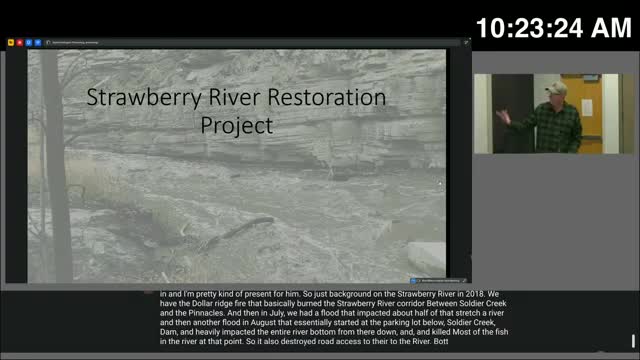Utah's Strawberry River Restoration Plan targets fish habitat and infrastructure post-fire
March 22, 2025 | Natural Resources Department, Utah Environment, State Agencies, Organizations, Utah Executive Branch, Utah
This article was created by AI summarizing key points discussed. AI makes mistakes, so for full details and context, please refer to the video of the full meeting. Please report any errors so we can fix them. Report an error »

The recent joint meeting of the Blue Ribbon and Habitat Council, held by the Utah Department of Natural Resources, focused on critical restoration efforts for the Strawberry River following devastating fires and flooding. The discussions highlighted the ongoing challenges and proactive measures being taken to restore the river's ecosystem, which is vital for local wildlife and community recreation.
One of the key topics was the impact of recent natural disasters on fish populations in the Strawberry River. Following a significant fire in 2017, surveys indicated record fish numbers, but subsequent flooding severely affected the habitat. The meeting revealed that efforts are underway to stock the river with cutthroat trout, which had previously been outnumbered by brook and brown trout. This initiative aims to restore the natural balance of fish species in the river, enhancing both biodiversity and fishing opportunities for local residents.
Additionally, the meeting addressed infrastructure improvements funded by Emergency Watershed Protection (EWP) money, which has been allocated to restore access to the river and repair damaged roads. The counties of Wasatch and Duchene are actively involved in these restoration efforts, which include the installation of protective structures to manage debris during floods.
A significant proposal discussed was the stabilization of Slab Lake, formed by flooding in the Strawberry River bottom. Tyler Allred, a restoration expert, presented plans to reinforce the lake's natural dam and improve fish habitat. This project is part of a broader watershed restoration plan aimed at enhancing the ecological health of the area.
The meeting concluded with a call for funding to support these restoration projects, with a request for $182,000 to cover materials and equipment costs, as well as ongoing tamarisk control efforts to prevent invasive species from taking hold in the river ecosystem.
As these restoration projects move forward, they promise to not only revive the Strawberry River's natural beauty but also ensure that it remains a cherished resource for the community, supporting both wildlife and recreational activities for years to come.
One of the key topics was the impact of recent natural disasters on fish populations in the Strawberry River. Following a significant fire in 2017, surveys indicated record fish numbers, but subsequent flooding severely affected the habitat. The meeting revealed that efforts are underway to stock the river with cutthroat trout, which had previously been outnumbered by brook and brown trout. This initiative aims to restore the natural balance of fish species in the river, enhancing both biodiversity and fishing opportunities for local residents.
Additionally, the meeting addressed infrastructure improvements funded by Emergency Watershed Protection (EWP) money, which has been allocated to restore access to the river and repair damaged roads. The counties of Wasatch and Duchene are actively involved in these restoration efforts, which include the installation of protective structures to manage debris during floods.
A significant proposal discussed was the stabilization of Slab Lake, formed by flooding in the Strawberry River bottom. Tyler Allred, a restoration expert, presented plans to reinforce the lake's natural dam and improve fish habitat. This project is part of a broader watershed restoration plan aimed at enhancing the ecological health of the area.
The meeting concluded with a call for funding to support these restoration projects, with a request for $182,000 to cover materials and equipment costs, as well as ongoing tamarisk control efforts to prevent invasive species from taking hold in the river ecosystem.
As these restoration projects move forward, they promise to not only revive the Strawberry River's natural beauty but also ensure that it remains a cherished resource for the community, supporting both wildlife and recreational activities for years to come.
View full meeting
This article is based on a recent meeting—watch the full video and explore the complete transcript for deeper insights into the discussion.
View full meeting

